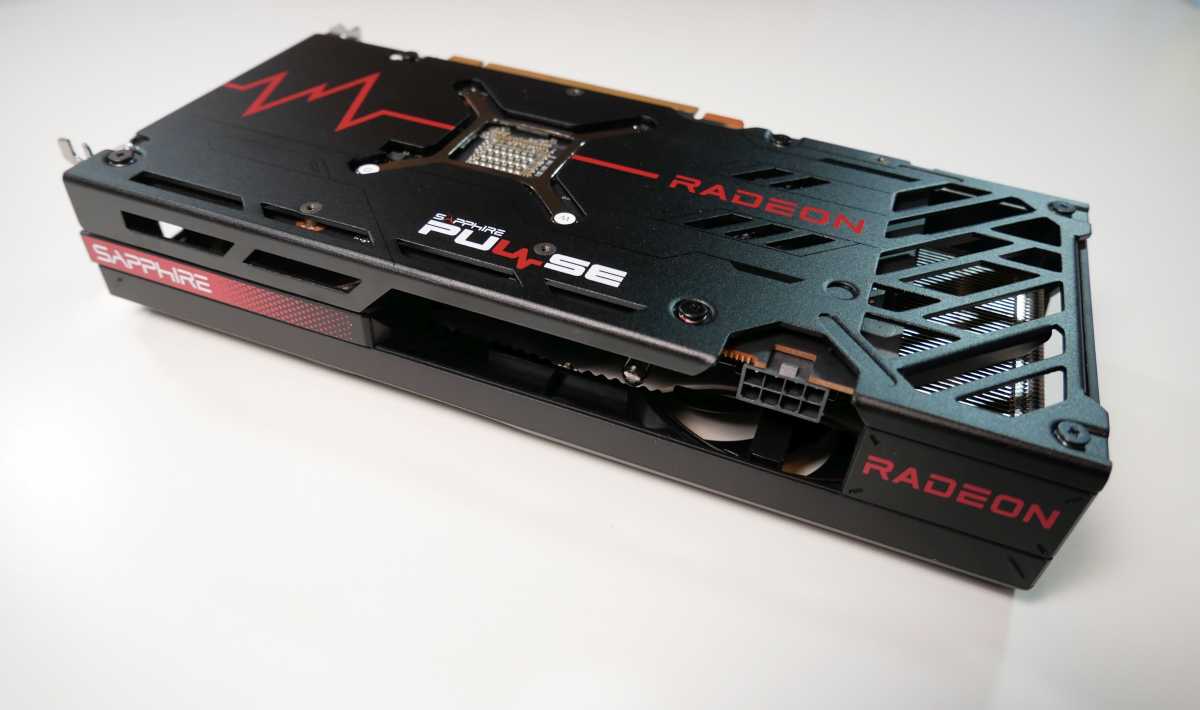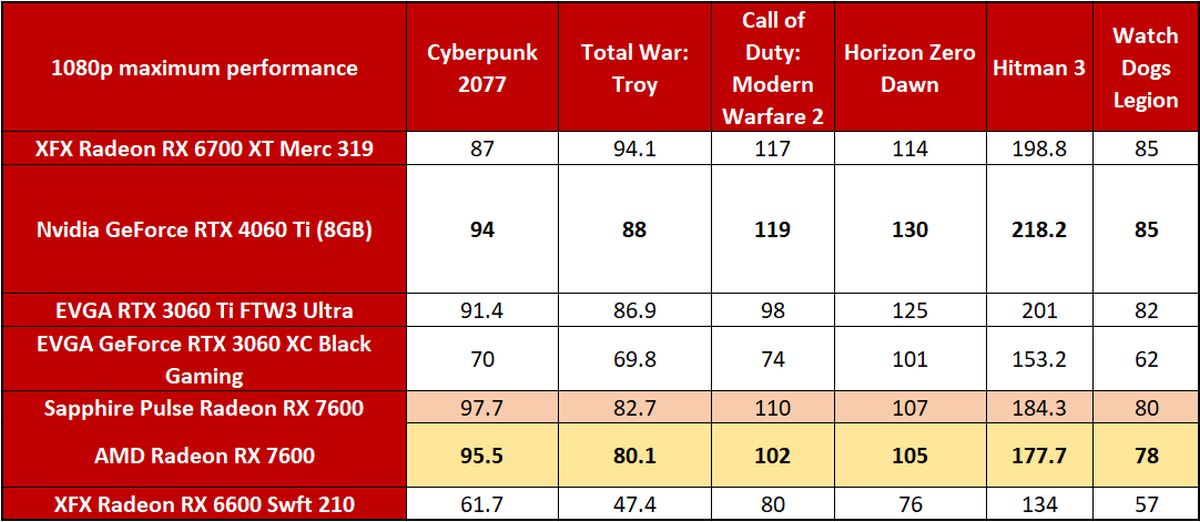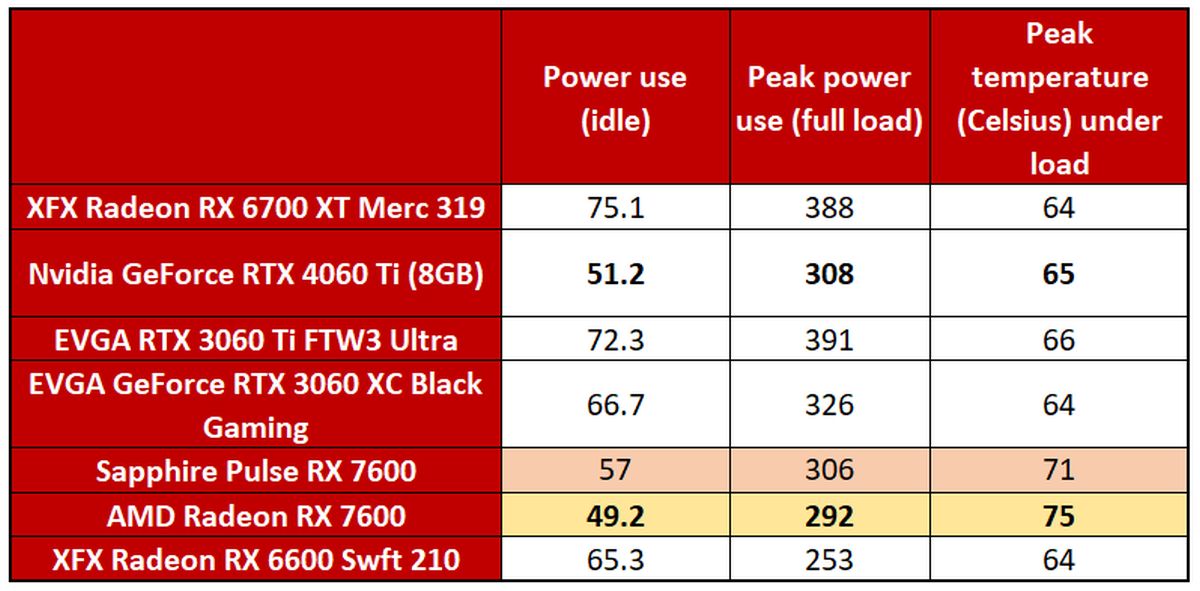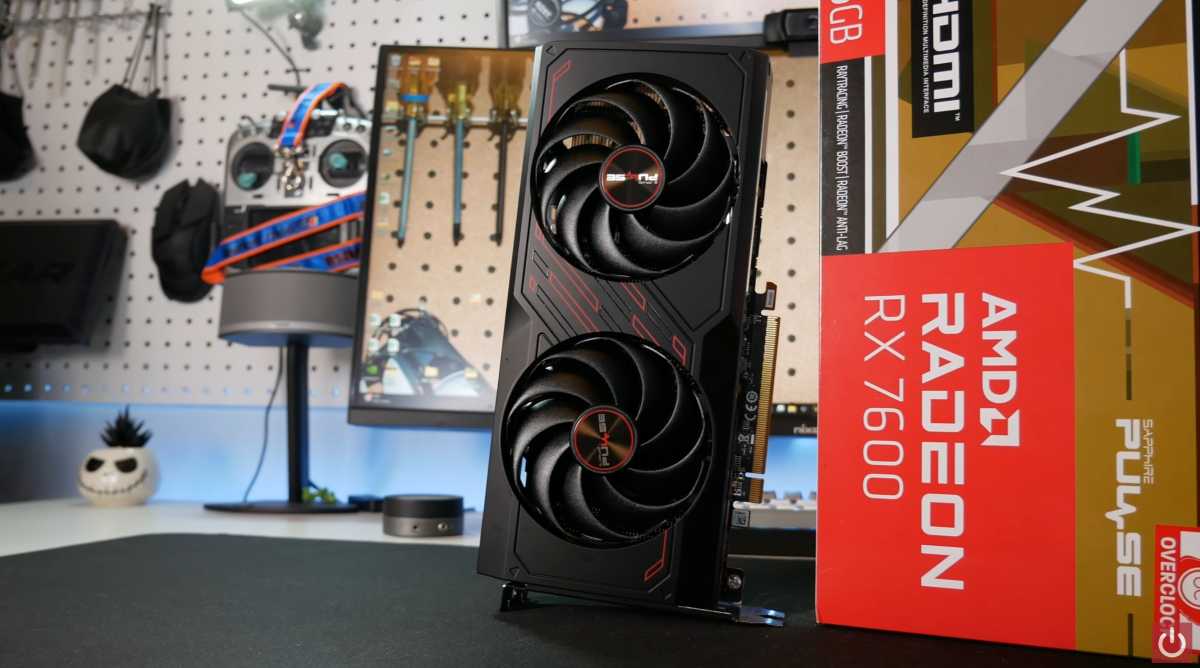Sapphire Pulse Radeon RX 7600 review: Cool, quiet, and compelling
 At a glance
At a glance
Expert’s Rating
Pros
- Great 1080p gaming performance with factory overclock
- Cool, quiet, and pretty custom cooling solution
- Affordable, doesn’t upcharge for the cooler
- Manageable two-slot design
- Only needs 8-pin power connector (no adapter needed)
- AV1 encoding
Cons
- Ray tracing performance is bad
- All image upscaling features (FSR/DLSS) look ugly at 1080p
- 8GB of VRAM; may need to dial graphics from Ultra to High in some particularly intensive games, even at 1080p
Our Verdict
Sapphire’s Pulse Radeon RX 7600 offers great 1080p gaming in a cool, quiet package for just $269. It’s a compelling low-cost graphics card and a great take on AMD’s new GPU.
Price When Reviewed
$269
The new $269 Radeon RX 7600 graphics card hits the streets today, and as we covered in-depth in our review of AMD’s reference model, it’s a breath of fresh air. After years of exorbitant GPU prices and stagnant new “upgrades,” the Radeon RX 7600 delivers a true generational improvement for a lower price than its predecessor—a winning combination. It offers fast, power-efficient 1080p gaming at an affordable price point. Enter Sapphire’s Pulse Radeon RX 7600.
We’ve loved Sapphire’s Pulse line since its introduction thanks to its laser-focus on excellent, cool, no-frills gaming for an affordable price, regardless of the GPU inside. That seems like a perfect combination with AMD’s new excellent, affordable GPU, no?
It is. After putting the card through its paces, we’re happy to report that the Sapphire Pulse Radeon RX 7600 is everything you would want from the RX 7600 lineup. It’s just big enough to carry a competent cooling solution without being obtrusive, all for the baseline $269 MSRP price.
Sapphire Pulse Radeon RX 7600 specs and features
We’ve included AMD’s breakdown of the Radeon RX 7600’s technical specifications below. Sapphire stuck mostly to reference specs with the Pulse, other than offering a slight factory overclock. The Pulse RX 7600 is rated for an average game clock speed of 2,356MHz, compared to the reference 2,250MHz.

AMD
We covered the Radeon RX 7600’s critical technical bits in our reference card review and won’t rehash that here. In addition to the raw upgrade to the new 6nm RDNA 3 architecture (which brings AV1 encoding, higher GPU and memory clock speeds, new AI accelerators, and second-gen RT accelerators), AMD also packed the GPU with flat-out more horsepower than its predecessor, the Radeon RX 6600 that launched at $329 in 2020. All told, the Radeon RX 7600 offers an average of 35 percent more 1080p gaming performance for 18 percent less money—a true generational upgrade. It falters in ray tracing, however, and upscaling technologies like AMD’s FSR and Nvidia’s DLSS look bad at this resolution.
The one aspect worth briefly readdressing here: the memory configuration. AMD equipped the Radeon RX 7600 with a tiny 128-bit bus and 8GB of onboard memory. That limits the Radeon RX 7600 to consideration for 1080p gaming (though it can handle 1440p with reduced settings)—a reasonable compromise in an affordable GPU, unlike identical compromises made in Nvidia’s $400 GeForce RTX 4060 Ti.
But PC gamers are worried that 8GB of memory capacity isn’t enough now that a swathe of modern triple-A games consume more than that regularly at Ultra resolution. Those edge cases are rare, however, and PCWorld contributor Keith May tested the Sapphire Pulse RX 7600’s performance in some of today’s most VRAM-hungry games to see what you can expect. You can see his analysis in the video below, but bottom line? If you bump graphics settings from Ultra to High in those most-intensive titles, you still get a killer 1080p gaming experience that looks great and runs fast. Again, at this affordable price point, that’s totally reasonable.
The Radeon RX 7600 is a testament to Sapphire’s strict ‘no-frills, just great gaming’ approach to the Pulse lineup.
Onto the Pulse itself.
Sapphire stuck to the tried-and-true Pulse design we’ve loved in cards like the Pulse RX 7900 XT and last-gen’s Pulse RX 6600 XT. It’s still good. The dual-slot card features a basic aluminum fin stack and a focus on low noise output, bolstered by Sapphire’s Dual-X Cooling technology. Dual “hybrid fan blades” and intelligent fan controls keep thing running nice, cool, and quiet—as you’ll see later, the Pulse offers much lower temperatures than AMD’s reference card, including peak hotspot temperatures. That’s a testament to Sapphire’s intentional design for all Pulse models.

Keith May/IDG
You won’t find any fancy extras like RGB lighting, dual-BIOS switches, or fan control headers on the switch, but those luxuries aren’t typical on budget-priced cards, or on custom offerings that hit the MSRP suggested by AMD and Nvidia. One minor sacrifice? While the AMD reference 7600 contains DisplayPort 2.1 connections, that’s an optional specification, and the Pulse relies on the same DisplayPort 1.4 technology that Nvidia offers in its RTX 40-series GPUs. The higher bandwidth provided by DP 2.1 would mostly be useless on a $269, 1080p-focused graphics card anyway, as it’s intended to power pixel-packed high-resolution displays at ultra-fast refresh rates.

Keith May/IDG
Aesthetically, the Pulse looks as good as ever, featuring a blacked-out design with red highlights and a gorgeous red “pulse” heartbeat traveling the length of the card’s metal backplate. (Yes, Sapphire still slapped a backplate on here despite the low price—always welcome, since bare PCBs look terrible when you’re using a case with a tempered glass window.) Power is handled via a simple, single 8-pin connection, no fiddly 12VHPWR adapters required.
Of course, as a modern AMD graphics card, the Sapphire Pulse can tap into AMD’s suite of Radeon features, such as Smart Access Memory for faster game performance in Ryzen + Radeon systems, Smart Access Video for faster encoding in all-AMD PCs, FSR 2, Radeon Super Resolution, Anti-Lag, and more. And the Radeon RX 7600’s new AV1 encoding works great with the Record & Stream features in AMD Adrenalin software, which might actually be a bit better than Nvidia’s vaunted Shadowplay now.
Onto the benchmarks!
Our test system
Keith May tested the Sapphire Pulse Radeon RX 7600 on his testing system, which runs using the same core components as Brad’s main PCWorld GPU testing rig. You can see Keith explain the components in his rig in video form here, while this link details what’s inside the main GPU rig. Keith provided numbers for the Zotac card; the comparison data was pulled from our just-updated database of GPUs using the main test rig.
We test a variety of games spanning various engines, genres, vendor sponsorships (Nvidia, AMD, and Intel), and graphics APIs (DirectX 9, 11, DX12, and Vulkan), to try to represent a full range of performance potential. Each game is tested using its in-game benchmark, sanity checked by Nvidia’s FrameView tool, at the highest possible graphics presets unless otherwise noted, with VSync, frame rate caps, real-time ray tracing or DLSS effects, and FreeSync/G-Sync disabled, along with any other vendor-specific technologies like FidelityFX tools or Nvidia Reflex. We’ve also enabled temporal anti-aliasing (TAA) to push these cards to their limits.
We run each benchmark at least three times and list the average result for each test. We’ve focused our testing on 1080p performance alone in a select handful of games, since our original Radeon RX 7600 review already established that this class of GPU is best suited for 1080p gaming without ray tracing enabled due to the way it’s technically configured. If you want to see all that work, go check out that review; the purpose of this one is to compare the Sapphire Pulse’s performance specifically against AMD’s reference 7600, hence limiting our benchmarks to a more focused selection.
Sapphire Pulse Radeon RX 7600 gaming benchmarks

Keith May/IDG
No surprises here. The Sapphire Pulse’s modest factory overclock and enhanced cooling let it eke out a few more frames than AMD’s reference Radeon RX 7600. It’s a great, affordable option for 1080p gaming with excellent visual fidelity and fast frame rates out of the box.
That’s notable, because as we covered in our reference 7600 review, performance-boosting image upscaling technologies like AMD’s FSR and Nvidia’s DLSS negatively affect visual quality at 1080p resolution, since they’re working with so many fewer pixels than at 1440p or 4K. So picking up a 1080p graphics card that offers a great native experience is key. The Sapphire Pulse Radeon RX 7600 checks that box with gusto.
Sapphire Pulse Radeon RX 7600 power and temperatures
Let’s start with the Sapphire Pulse’s power draw, though the thermals and acoustics are the real draw here.
We test power draw by looping the F1 22 benchmark at 4K for about 20 minutes after we’ve benchmarked everything else (to warm up the GPU) and noting the highest reading on our Watts Up Pro meter, which measures the power consumption of our entire test system. The initial part of the race, where all competing cars are onscreen simultaneously, tends to be the most demanding portion.
This isn’t a worst-case test; this is a GPU-bound game running at a GPU-bound resolution to gauge performance when the graphics card is sweating hard. If you’re playing a game that also hammers the CPU, you could see higher overall system power draws. Consider yourself warned.

Keith May/IDG
The Sapphire Pulse comes with a small factory overclock and offers slightly faster performance than the AMD Radeon RX 7600 reference card, so it’s no surprise to see it draw slightly more power. The energy consumption remains small enough that you don’t need to worry about it whatsoever.
Onto the Pulse’s strong suit. We test thermals by leaving GPU-Z open during the F1 22 power draw test, noting the highest maximum temperature at the end.
Sapphire’s straightforward, but effective Pulse cooling design impresses yet again. Not only does the Pulse keep overall GPU temperatures lower than the Radeon RX 7600 reference design, it tames the peak GPU hotspot temperature more effectively too, maxing out at 84 degrees Celsius on the Pulse and 90 degrees on the reference model.
Better yet, the Pulse runs exceptionally quiet, a focus of Sapphire’s cooling design for the line. You’ll barely (if ever) hear it even under load, and the card offers idle fan stop capabilities that stop the blades from spinning whatsoever if you aren’t gaming or performing other GPU-intensive loads. The reference card is very quiet, too, but the Pulse does it while running cooler and faster.
Should you buy the Sapphire Pulse Radeon RX 7600?

Keith May/IDG
If you’re looking for an affordable 1080p graphics card, this should absolutely be on your short list. The Radeon RX 7600 is the first low-cost GPU launch worth praising in years, and the Sapphire Pulse runs faster, cooler, and just as silent as AMD’s reference card, all for the same wallet-friendly $269 price tag.
It’s a testament to Sapphire’s strict “no-frills, just great gaming” approach to the Pulse lineup, which proves especially welcome here in the budget segment. Modern AV1 encoding is a delectable cherry on top for streamers.
You shouldn’t turn on ray tracing with the Radeon RX 7600, or buy it for 1440p gaming. Our much more detailed original AMD Radeon RX 7600 review breaks down why in exacting depth (along with suggesting potential alternatives if desired). But those aren’t necessarily drawbacks in this mainstream price range. If you want to buy a modern graphics card that you can plop into your system and experience fast, high-fidelity 1080p gaming with minimal hassle—and without busting your bank account—the Sapphire Pulse Radeon RX 7600 is well worth buying.
For all the latest Technology News Click Here
For the latest news and updates, follow us on Google News.
